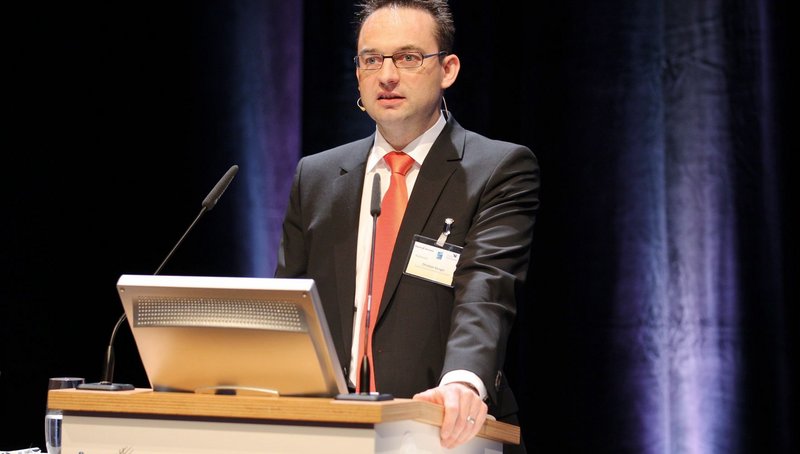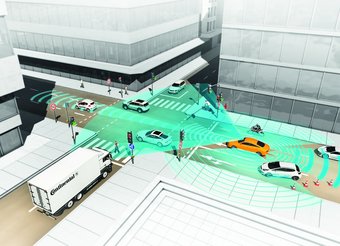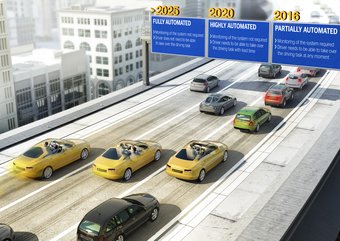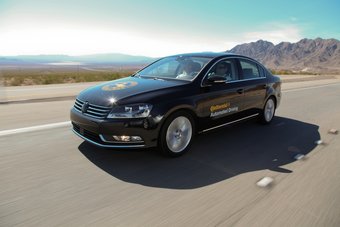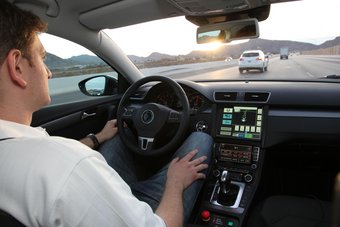Automated Driving to Become as Standard as ABS and ESC
- Continental head of research for automotive electronics Senger calls for systematic industrialization of automated driving
- Challenges at research level require automation to be implemented step-by-step
- Complexity of the technology demands close alliance between system suppliers and manufacturers
- As a system supplier, Continental is perfectly set up to be a key driving force in the industrialization of automated driving
Munich/Hanover, July 1, 2013. International automotive supplier Continental calls for systematic industrialization of automated driving. "Continental is convinced that automated driving will make private transport even safer, more comfortable, and more efficient in the future," said Continental head of research for automotive electronics, Christian Senger, during the "Zulieferer Innovativ 2013" Congress at BMW Welt on Monday in Munich. The automotive supplier is keeping a close eye on the industrialization of this technology.
"Automated driving is set to become just as much a standard part of driving as anti-lock brakes (ABS) 35 years ago and electronic stability control (ESC) in 1995. However, the change to fully-automated cars will not happen overnight, as there are still many challenges to overcome in terms of research and development work. Consequently, automation will be introduced step-by-step, from partial automation through highly automated systems to full automation," explained Senger. He also addressed the role of suppliers – a role that, given the highly complex technology involved, can only be performed by a system supplier: "Alongside the electrification of cars, automated driving is undoubtedly the biggest task facing the automotive industry in the next 10 to 15 years. The complexity of this technology is a major challenge, and one that, in terms of suppliers, only system suppliers will be able to meet."
Senger underlined the need for even closer cooperation between suppliers and automotive manufacturers: "The highest level of system reliability across domain boundaries is the indispensable basis on which automated driving must be built. This can only be achieved if manufacturers and system suppliers form an even closer alliance in research and development. Our joint research cooperation with the BMW Group is a clear recognition of this fact."
Automated driving to be implemented step-by-step
In terms of the technology involved, automated driving is an evolution of driver assistance systems already being industrialized. Its systematic networking with driver information and drive systems is gradually advancing the concept toward its goal. From 2016, partially automated systems could already be assisting drivers in "stop & go" situations on the freeway at low speeds of up to 30 km/h. But this initial step toward automation does not relieve drivers of their responsibility to constantly pay attention to what is happening on the road. This step may come to fruition with the implementation of highly automated driving from 2020.
As well as covering higher speeds above 30 km/h on the freeway, highly automated driving will allow drivers to use the time they would ordinarily spend driving to carry out other activities, such as reading the latest headlines online. With both levels of automation, however, the driver must be able to take control of the vehicle at all times. But when fully automated driving is possible in 2025, even this may no longer be necessary. On the freeway, a fully automated vehicle will have full and independent control of driving up to 130 km/h.
But when the vehicle reaches the desired exit, for example, the driver will have to take control, even with this high level of automation. When fully automated systems become available in 2025, they will still be limited to driving on the freeway. However, if the driver fails to respond to a demand to take control here, the vehicle will return to a safe state by itself, i.e. by braking and stopping on the hard shoulder.
Long-standing research expertise in the field of automated driving
Automated driving is one of the central themes of the international automotive supplier's technology strategy. Today, more than 1,300 specialists at Continental are already working on the basics of automated driving, including driver assistance systems such as adaptive cruise control and emergency brake assistance. For this and for further step-by-step automation, Continental is investing more than €100 million in R&D in 2013.
Continental already sees itself as a leading manufacturer of driver assistance systems. Since the first series project in 1999 for the Mercedes S-Class, the company has realized more than 100 projects for automotive manufacturers worldwide. What is more, Continental has racked up many years of experience in the design of display and user interfaces and in the energy management of drivetrain systems. Strategic advanced development coordinates system level integration on a cross-domain basis.
In conjunction with its network of partners in the field of information and communication technology, this setup enables Continental to realize a holistic approach to automated driving. The internationally operating supplier can also look back on several years of development activities in the field of automation. Back in 2011, for instance, as part of the EU research project HAVEit, the company developed a highly automated assist system for driving in traffic jams and around roadworks as an example of a complex traffic scenario.
Alongside its involvement in other research projects (AKTIV, DARPA Urban Challenge), the company completed a two-week endurance test with close-to-production technology in the U.S. state of Nevada in early 2012. Over 15,000 miles of mostly highly automated driving were completed there on public roads. In December 2012, the Nevada (U.S.A.) Department of Motor Vehicles (DMV) authorized Continental's use of the company's vehicle in the state for the purpose of testing automated driving. Continental is the first automotive supplier to receive this kind of license from the relevant homologation authority.
Research partnership with the BMW Group
In January 2013, Continental and the BMW Group signed a research cooperation agreement in order to jointly develop highly-automated driving systems for the freeway. The cooperative project runs until the end of 2014. Several prototype test vehicles equipped for automated driving are set to be built in the course of these two years. The research prototypes will then be made available to a select team of trained test participants. Tests will involve analyzing highly automated driving functions using close-to-production technology not only on German freeways but also on freeways in other European countries. The tests will cover all the challenges posed on freeways, such as interchanges, toll plazas, and roadworks.
Legislation is decisive when it comes to market launch
System reliability forms the basic technical requirement for the realization of automated driving. Road safety at the highest level is therefore the indispensable basis on which automated driving must be built. In concrete terms, this calls for fail-safe architecture that keeps the vehicle in a safe state in the event of a fault. However, the time frame for development of this required safety architecture will not be the only factor that determines when the new systems will be launched. Legislators will play a crucial role in determining when and how autonomous vehicles can be introduced to the market. The necessary legal framework has yet to be drawn up.
